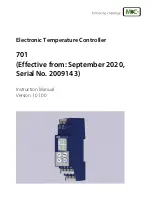
LTC3703-5
22
37035fa
Boost Converter: Power MOSFET Selection
For information about choosing power MOSFETs for a
boost converter, see the Power MOSFET Selection sec-
tion for the buck converter, since MOSFET selection is
similar. However, note that the power dissipation equa-
tions for the MOSFETs at maximum output current in a
boost converter are:
P
D
I
D
R
V
I
D
R
C
V
V
V
f
P
D
I
R
MAIN
MAX
MAX
MAX
DS ON
OUT
MAX
MAX
DR
MILLER
CC
TH IL
TH IL
SYNC
MAX
MAX
DS ON
=
⎛
⎝⎜
⎞
⎠⎟
+
( )
+
⎛
⎝⎜
⎞
⎠⎟
( )(
)
+
⎡
⎣
⎢
⎢
⎤
⎦
⎥
⎥
( )
=
⎛
⎝⎜
⎞
⎠⎟
( )
+
( )
1
1
1
2
1
1
1
1
1
1
2
2
2
–
–
•
–
–
–
(
)
( )
( )
(
)
δ
δ
Boost Converter: Output Capacitor Selection
In boost mode, the output capacitor requirements are
more demanding due to the fact that the current waveform
is pulsed instead of continuous as in a buck converter. The
choice of component(s) is driven by the acceptable ripple
voltage which is affected by the ESR, ESL and bulk
capacitance as shown in Figure 15. The total output ripple
voltage is:
∆
=
+
⎛
⎝⎜
⎞
⎠⎟
V
I
f C
ESR
D
OUT
O MAX
OUT
MAX
(
)
•
–
1
1
where the first term is due to the bulk capacitance and
second term due to the ESR.
The choice of output capacitor is driven also by the RMS
ripple current requirement. The RMS ripple current is:
I
I
V
V
V
RMS COUT
O MAX
O
IN MIN
IN MIN
(
)
(
)
(
)
(
)
•
–
≈
At lower output voltages (less than 30V), it may be
possible to satisfy both the output ripple voltage and RMS
ripple current requirements with one or more capacitors of
APPLICATIO S I FOR ATIO
W
U
U
U
Figure 15. Output Voltage Ripple
Waveform for a Boost Converter
RINGING DUE TO
TOTAL INDUCTANCE
(BOARD + CAP)
∆
V
ESR
∆
V
COUT
V
OUT
(AC)
a single capacitor type. However, at output voltages above
30V where capacitors with both low ESR and high bulk
capacitance are hard to find, the best approach is to use a
combination of aluminum and ceramic capacitors (see
discussion in Input Capacitor section for the buck con-
verter). With this combination, the ripple voltage can be
improved significantly. The low ESR ceremic capacitor
will minimize the ESR step, while the electrolytic will
supply the required bulk capacitance.
Boost Converter: Input Capacitor Selection
The input capacitor of a boost converter is less critical than
the output capacitor, due to the fact that the inductor is in
series with the input and the input current waveform is
continuous. The input voltage source impedance deter-
mines the size of the input capacitor, which is typically in
the range of 10
µ
F to 100
µ
F. A low ESR capacitor is
recommended though not as critical as for the output
capacitor.
The RMS input capacitor ripple current for a boost con-
verter is:
I
V
L f
D
RMS CIN
IN MIN
MAX
(
)
(
)
. •
•
•
=
0 3
Please note that the input capacitor can see a very high
surge current when a battery is suddenly connected to the
input of the converter and solid tantalum capacitors can
fail catastrophically under these conditions.
Be sure to
specify surge-tested capacitors!
Boost Converter: Current Limit Programming
The LTC3703-5 provides current limiting in boost mode by
monitoring the V
DS
of the main switch during its on-time
and comparing it to the voltage at I
MAX
. To set the current
limit, calculate the expected voltage drop across the
MOSFET at the maximum desired inductor current and











































